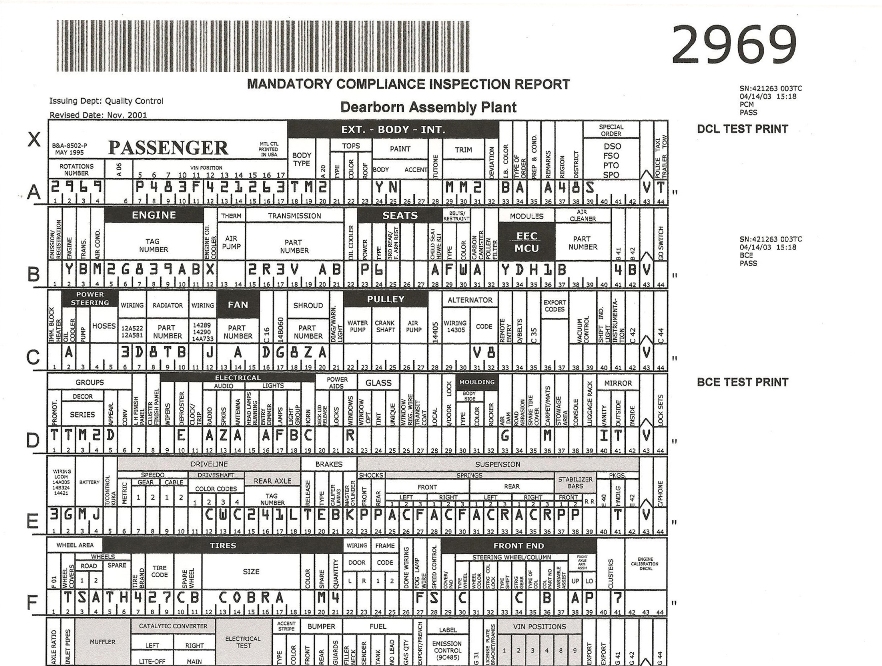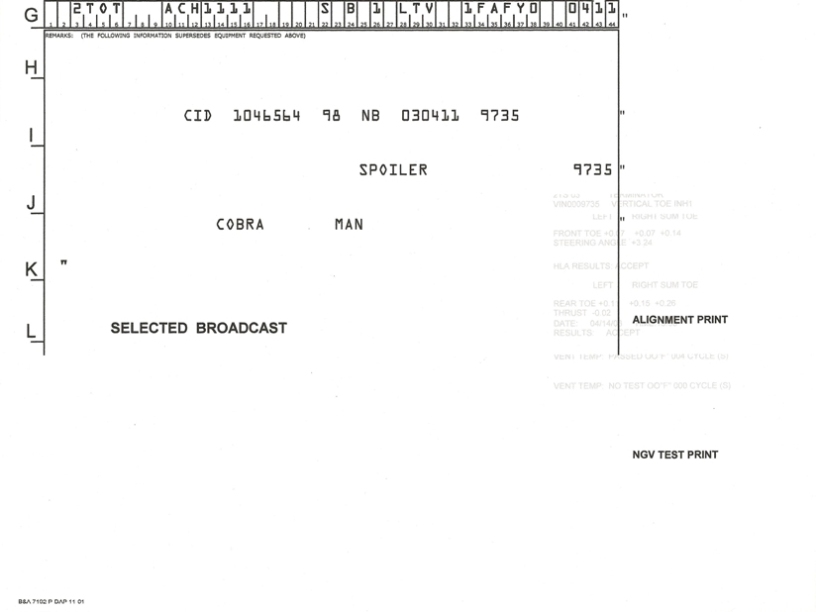Build Sheets
As previously mentioned, there is not just a single sheet that goes with the car, but a series of them. Unfortunately, they all usually get tossed as the body makes its way down the assembly line, or occasionally one will find its way crammed in to some obscure location on or in the vehicle. It is too bad the specialty vehicles did not have these included as part of the delivery, especially if you are fanatical about documentation, but here is just about every thing you may have wanted to know about them.
Since vehicles are not built in VIN order, the assembly line workers need to keep track of what goes where, hence these sheets. Among many details, each contains the VIN and date stamp, along with important "Rotation" and "Blend" numbers. Blend denotes the "blending" of the chassis and body to form the actual vehicle, which is assigned according to the build date, and Rotation indicates the vehicle position on the line during its particular build shift. Each number is used internally only, and start at 0001 and go through 9999, then reset. If you have ever removed your front bumper and noticed a label on the driver's side of the bumper support, you may actually find your rotation number.
On the bottom of each sheet, you will also see a specific notation for COBRA, with its blend number after. There is also SPOILER listed, unless you happen to have one of the odd cars without one, in which case it is left off. While many of the remaining codes on these sheets are a mystery, I'll do my best to share some of the items I have learned over the years. Some things are relatively obvious while others are not. Either way, I hope you will find this page informative!
Axle
The axle build sheet for the Terminator would be hanging from the IRS cradle. Chances are, you may have even found the piece of tape on the back that once held it. The Terminator IRS Axle model number of 241 - with an L revision - is shown and stamped on the differential tag (earlier builds had a 241-K stamp).
The "Suspension RR" box lists the coil spring code of ACR which is specific to the rear (for more information on the spring codes, refer to the Chassis sheet below). Also, the unique driveshaft is noted with the code CWC, which I surmise is a reference to the stripe colors on it: Charcoal/White/Charcoal.
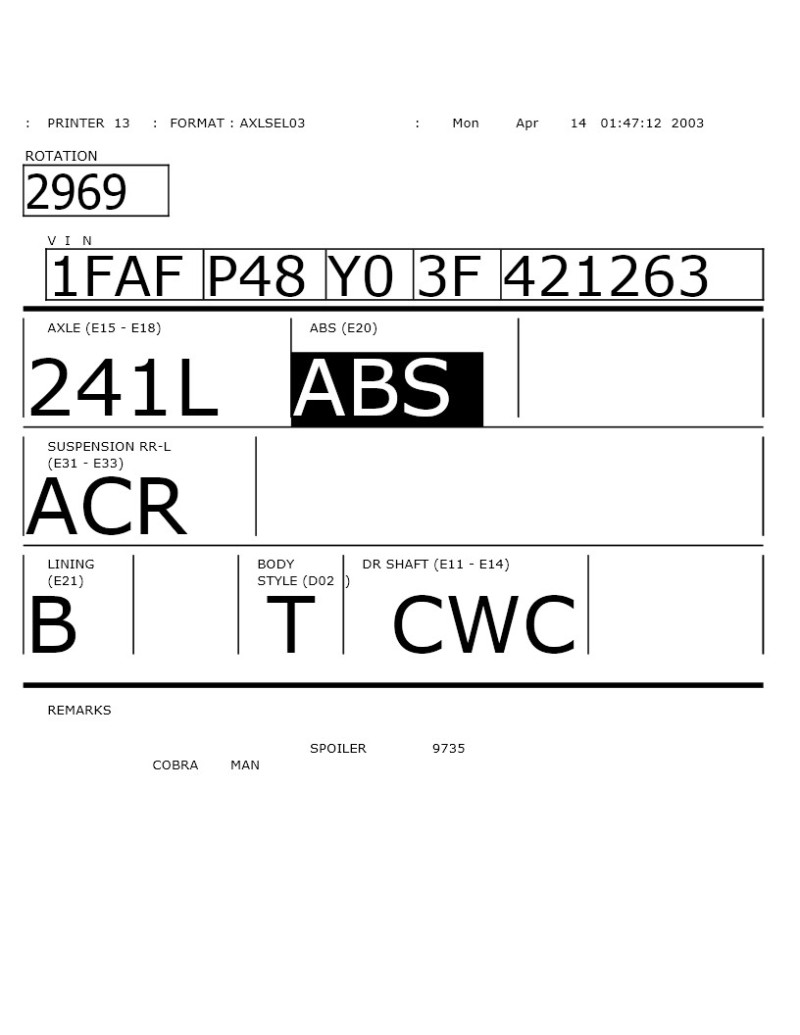
Chassis
The Chassis build sheet comes in a set of two, attached to each fender. They also start off in a similar fashion, with the rotation number and VIN, but get in to more detail with regards to the suspension and body. The spring codes of ACF (front) and ACR (rear) are also listed, which are both specific to coupes. For convertibles, these would be BCF and BCR for front and rear, respectively.
Although repeated on several pages, it is worth pointing out the engine identifier of Y, which is specific to the 4.6 DOHC Supercharged engine. Next to it, the transmission code of B is present for the T-56 (and is also shown on the VIN label). The axle code of 241 is also repeated, along with the paint code of YN (Silver Metallic in this case).
The machined wheels correlate to SA, whereas VB would have been for chrome, and I believe SV for 10th Anniversary models. Also, the PP under "stabilizer" denotes the purple daub of paint you would find on the Terminator-specific front bar. For the "shocks", the P is used for the Coupes, and W would be listed for a convertible. If your vehicle was also destined for Canada (or a cold climate), the addition of a block heater would also be indicated in the "IMM BLK HTR" box for Immersion Block Heater. Note the word COBRA under tire size - specific to the Goodyear Eagle F-1 tires.
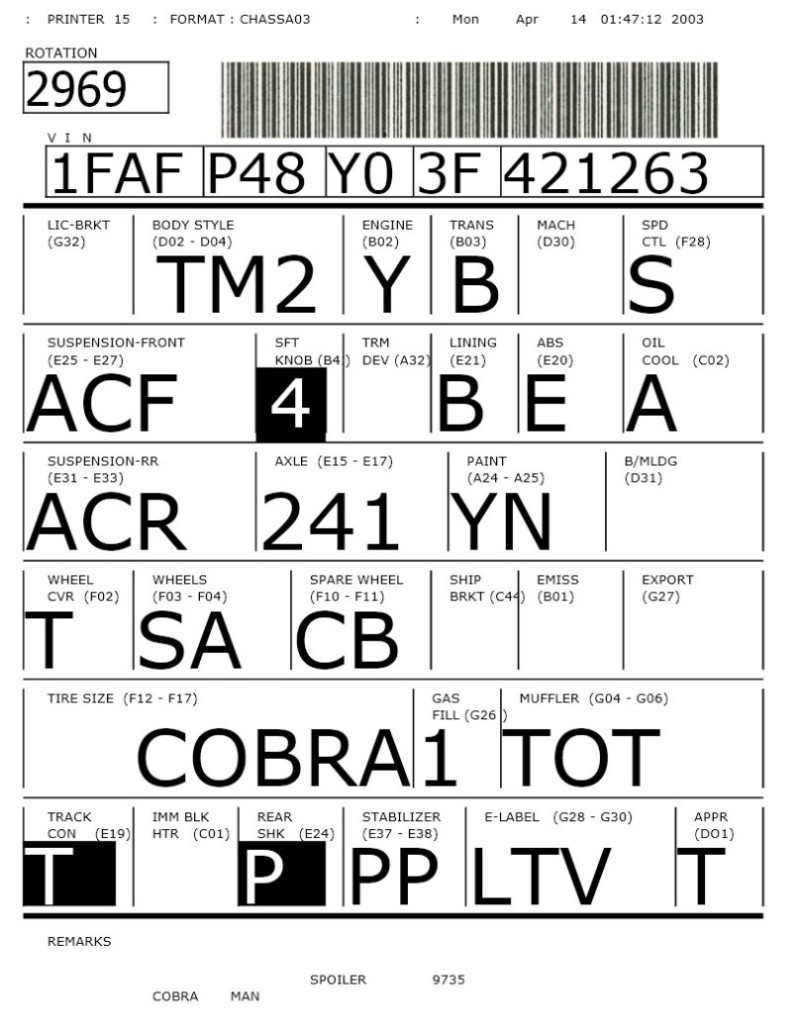
Engine
This would be hanging from the cradle that delivers the engine to the appropriate vehicle in the plant. The number on the upper left matches a tag you will find on the driver's side cam cover, right behind the power steering reservoir (37 in this case). The engine code at the bottom of the page of 839A, unique to the Terminator, can been seen on both cam covers just above the exhaust manifolds. The drivers side label for mine was actually 2G 839 AB, whereas earlier engines would have an AA suffix, or AC for the later engines.
The passenger side label also contains the actual serial number of the engine, which is listed on the HVBoM. These labels also show the build date of the engine, and when it was assembled at the Romeo engine plant, they were printed and attached. Again, Romeo Must Supply has plenty of great details and photos.
Also, there is the "Trans Tag", with 2R3V AB, which is stamped on the metal tag near the back of the transmission (the complete engineering number is actually 2R3V-7003-AB). This tag also contains the serial number and the Tremec model number, TUET1694. For 2004, that would have been 4R3V AA (4R3V-7003-AA), with the Tremec model number of TUET2060. Like with the engine, the transmission serial number will appear on the HVBoM in the summary box at the top.
Beneath the "Trans Tag" box, there is a letter G that refers to the battery harness, or "WR". The G represents the harness that does not contain the factory block heater cable. If your car had the block heater, the letter here would be an F.
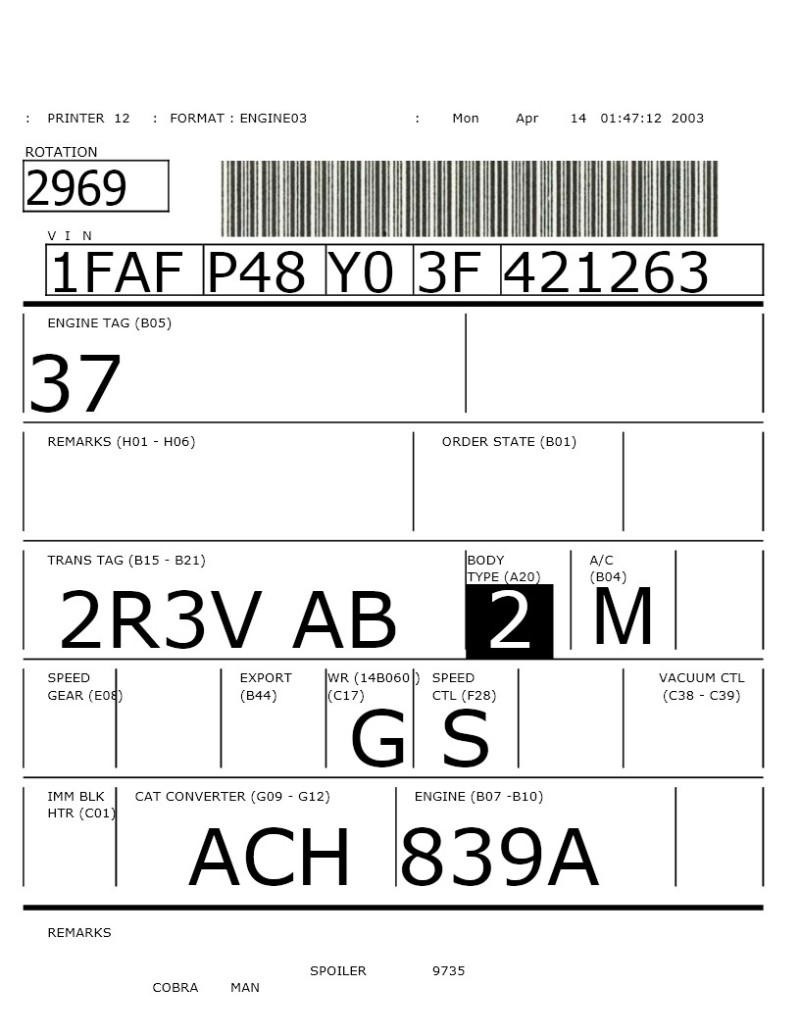
Instrument panel
The "IP" sheet goes with, of all things, the instrument panel, which is built up on a separate "mini-line". The "CB" under body style is specific to the Cobra. Next to it, the "2D" refers to a coupe, and a convertible would show as "CN". Also, there is a cluster code of 7 printed on this sheet that means the speedometer reads in MPH. For Cobras that went to Canada, this would have been an 8 for KPH (or "KM/H" as the speedometer is labeled). At the lower right, the blend number now shows up prominently.
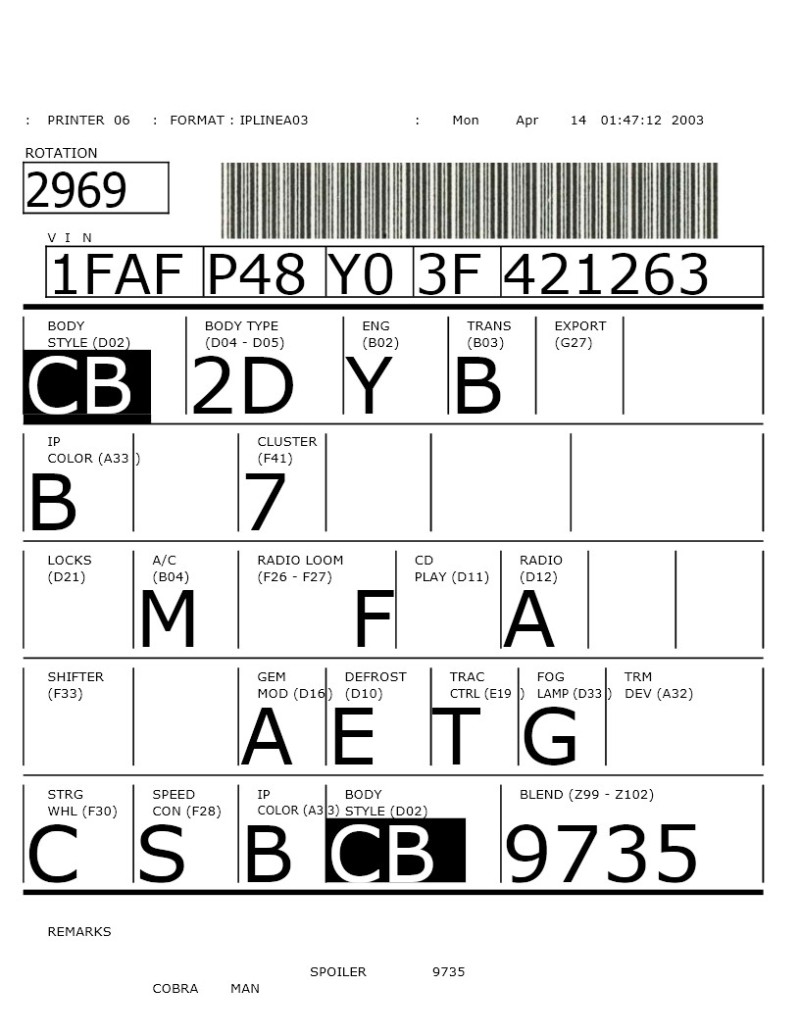
Trim
The Trim sheets are attached to bumper supports, both front and rear. If you are fortunate to find any sheet with your car, this would probably be the one (well, one of them, anyway). They also add an item that isn't shown on the others: the CID, or "Chassis ID number", which is found on the buck tag attached to the radiator support (generally on the driver's side, behind the headlight). Mine is 1046564. Also, don't get this confused with paint tag that occasionally shows up dangling from the radiator support - it is blank and is only for color reference (image thanks to Phil J., of Cape Cod, MA).
Some of the codes on this sheet - and many others, for that matter - are specific to coupes and convertibles such as "CVT Top", if it were present. The reverse-highlighted "Body type" of TM2 refers to a coupe, and TMC would be for a 'vert. Beneath that is "14A005" which is for the body harness specific to either vehicle (G for coupe, H for convertible). The reverse-highlighted J under "14290" refers to the headlight harness for a U.S. vehicle, whereas one destined for Canada (with Daytime Running Lights) would show K.
Another item of interest is the computer code, which is actually split between two boxes labeled "EEC MOD". Here you have YD & H1. This is also what I would see if I looked at the jamb of my passenger door: a white label with YDH1 (it is also obviously on the computer itself). There are actually many variations on the computer codes, but this list does show all I have known to exist. Also note "T" under the "SPLR" box lower right, most likely referring to the specific Terminator spoiler.
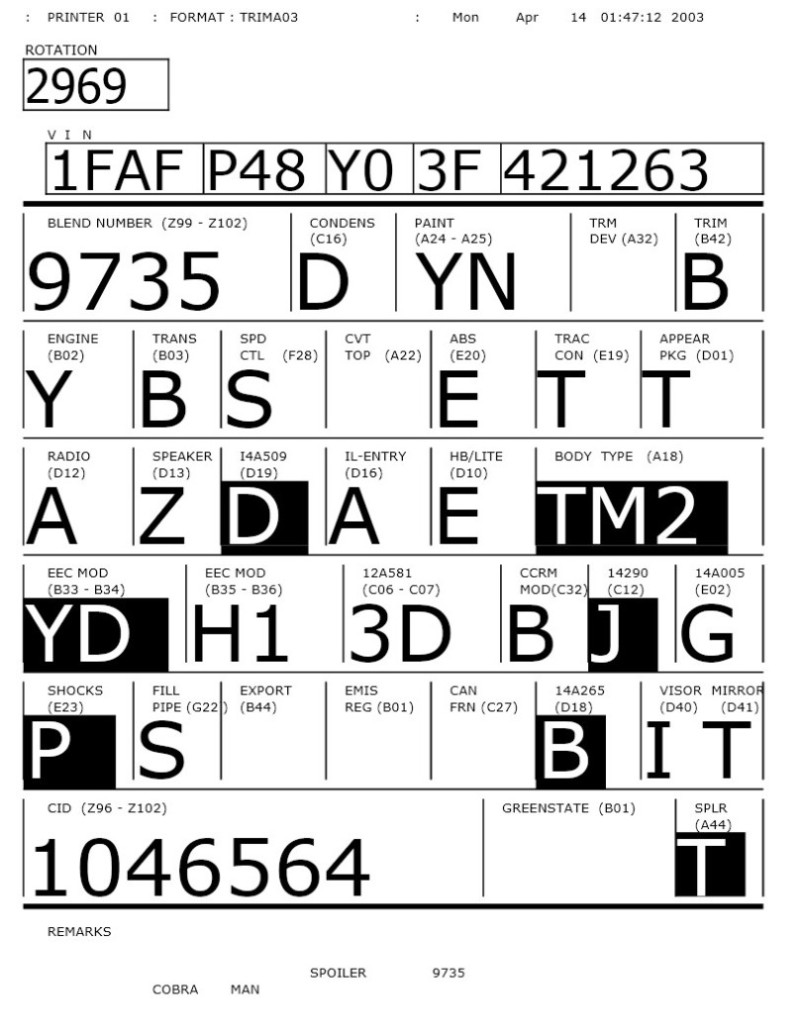
Master build sheet
This large sheet (11x17) could probably be considered the "Birth certificate" of the vehicle, or at least the true "build" sheet. At one point, these were kept on file at DAP, but for how long, I do not know. Along with being a complete build summary, there is an alignment print on the lower right along with electrical test information on the upper right, both showing the date. Towards the bottom, there is also some information from the buck tag. For the most part, corresponding boxes on each build sheet match up to those here by following the row and column designations. Since it is on the large side, I went ahead and scanned it as two separate sheets, but they line up almost perfectly for easy viewing.
